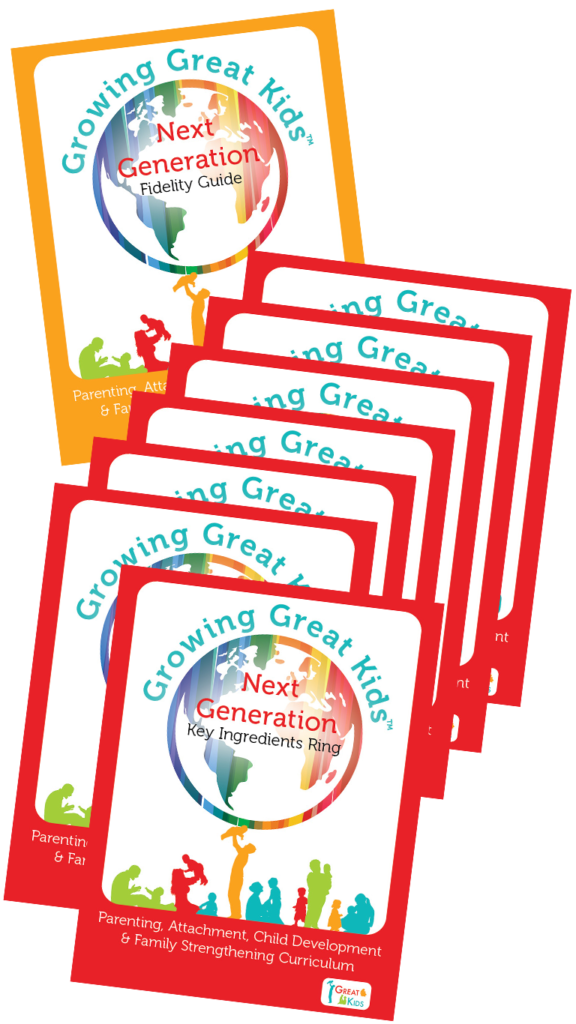There’s no denying that technology has enhanced our lives in many ways, however it also brings with it certain challenges. Unfortunately, parenting has not escaped those challenges that accompany our ever-changing technological world. In today’s blog, we will explore why parents should encourage play through parent-child interactions versus the use of media and technology to promote bonding and attachment, learning, and school readiness. We will also discuss how the Growing Great Kids Curriculum supports building parenting and life skills through hundreds of child development activities and other essential GGK tools designed to support secure attachment relationships— something we all want for our children!
Let’s start with what research tells us about the benefits of interaction and learning through unstructured and unplugged play. In 2011, Rose Ahern and a group of colleagues wrote that the benefits of play go beyond gross motor development and physical fitness. Play has many positive effects on children’s well-being and cognitive abilities. Interactive play supports the development of creativity, problem-solving, critical thinking, anticipatory planning, sense of equity, social connectedness, and even complex brain structures. These researchers also found play to be essential for building family bonds and encouraging open expression of feelings (Rose Ahern, et.al, 2011). What’s critical is the type of play. For optimal learning, play should include lots of interactions with people, not play that involves screens.
Most of us have witnessed how attracted babies and toddlers are to technology- this includes TV, tablets, smart phones, laptops, built-in DVD players in automobiles, etc. This is mainly because all these devices provide colorful images, movements, and sounds that capture everyone’s attention – babies are no exception. Parents have also discovered that infants and toddlers can stay “busy” with electronics leaving the parent free to take care of household tasks or engage in conversations and interactions with other adults. While there are numerous electronic apps claiming that young children will learn letters, numbers, words, etc., the American Academy of Pediatrics (AAP) believes that there are significantly more potential negative effects of media than positive ones for children 0-2 years of age. Thus, the AAP discourages media use by children younger than 2 years. The AAP also advises that unstructured playtime is more valuable to the developing brain than any electronic media exposure (The American Academy of Pediatrics, 2011).
Many of us (and likely the parents you work with) came across an article that was making the rounds on social media last fall. It indicated that the American Academy of Pediatrics had changed this longstanding recommendation of no screen time for children under the age of two. This caused a bit of panic for some of us. It was hard to believe that pediatricians were now okay with the idea of babies playing on their IPads while the TV blared in the background.
It’s important to note that the headline wasn’t really telling the whole story. The truth is that AAP has put together a committee of experts who are still discussing possibilities for being “more expansive in their next set of guidelines – which they aim to have out in the Fall of 2016.” (Reddy, 2015) Ari Brown, the doctor who is chairing this committee explains that they are investigating children’s media usage because “all technology is not the same.” Dr. Brown reminds us that “if you’re looking at children under 2, there’s a big difference between endless hours of watching cartoons on YouTube and video-chatting with Grandma.” (Reddy, 2015) Many of the studies presented to the committee at this symposium spent time highlighting the value of back-and-forth communication in children’s learning.
The GGK curriculum is designed to foster exactly that kind of interaction between children and parents. It provides hundreds of GGK child development activities as well as other essential tools to foster the growth of secure attachment relationships while also supporting critical developmental domains. Let’s take a moment to discuss some of these tools.
Every GGK unit incorporates modules designed to support development in the areas of Basic Care, Social and Emotional, Cues and Communication, Physical and Brain, and Play and Stimulation. Each area incorporates activities that support different developmental domains. Each activity handout references not only the benefits for the child and the parent (the “why’s” of the activity) but also lays out step by step the “how” to do the activity. During home visits, program families engage in toy making using household items and play time with their infants and toddlers. This creates many opportunities for parents and children to experience joyful interactions together. The curriculum is designed to encourage creative thinking in both parents and children and prepare them to feel competent now and as children transition through school.
GGK’s Ready for Play is another effective attachment tool designed to support parents in enhancing their engagement and re-engagement skills. As we mentioned above, today’s technology creates more distractions and parents often find it challenging to engage their infants and young children in other types of play and learning. When parents incorporate the Ready for Play tool, they are growing their skills in assessing if their child is ready to engage in a child development activity or not, AND to reflect on how they can make child development activities fun and interesting to their child.
In the end, we want to create learning environments that help children reach their potential. It is important to keep in mind that babies learn a lot when they play. Thus, as home visitors, we should take every opportunity to support parents to enrich their environments with playful experiences that will stimulate optimal development. We know that playing and having fun with children is the best way to grow great kids!
Works Cited:
Ahern, Rose, Beach, Rebecca, Leibke, Stephanie Moats, Proud, Ian, Spencer, Anne-Marie,Strickland, Eric. (2011). The benefits of play go well beyond physical fitness. Exchange: The Early Childhood Leaders’ Magazine since 1978,(201), 68.
Reddy, S. (2015, October 12). Pediatricians Rethink Screen Time Policy for Children. Retrieved from Wall Street Journal – WSJ.com: http://www.wsj.com/articles/pediatricians-rethink-screen-time-policy-for-children-1444671636
The American Academy of Pediatrics (2011). Media Use by Children Younger Than 2 Years. Pediatrics Volume 128, Number 5. Retrieved from www.pediatrics.org/cgi/doi/10.1542/peds.2011-1753

